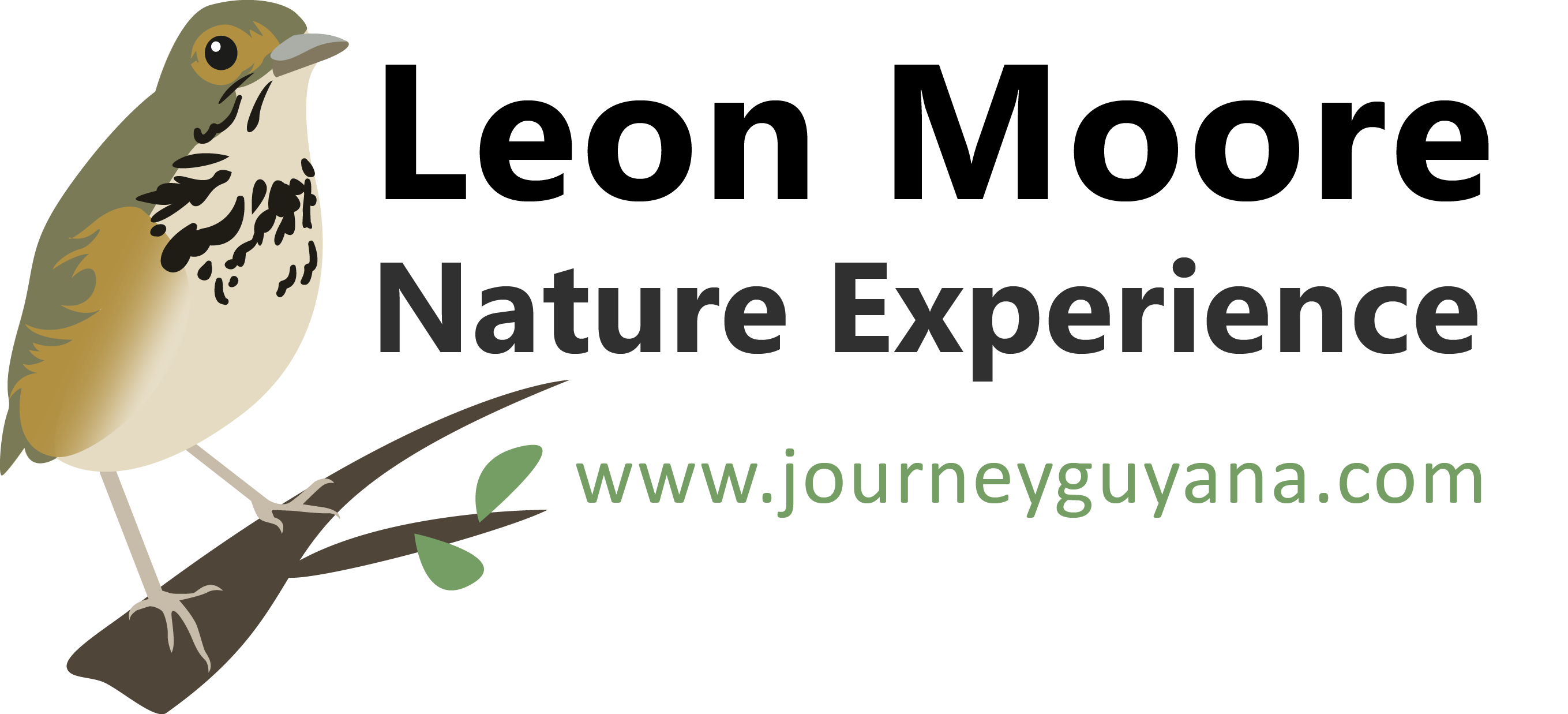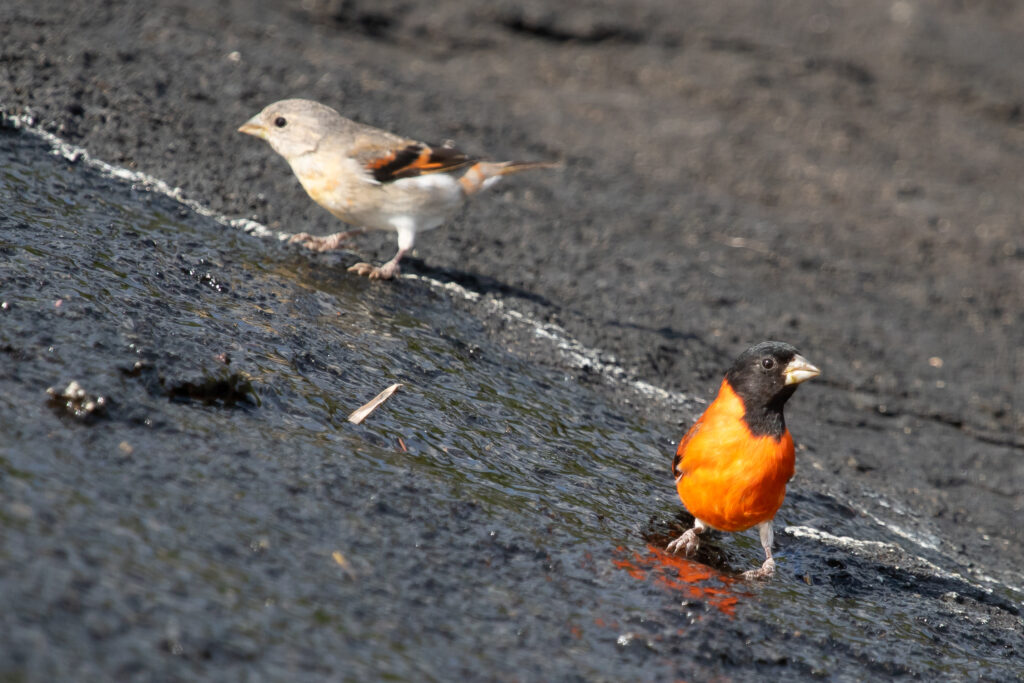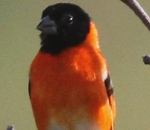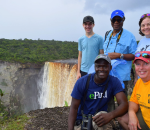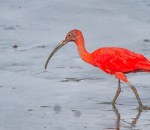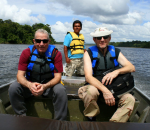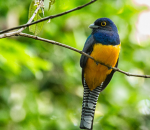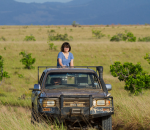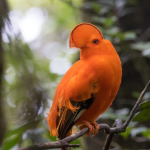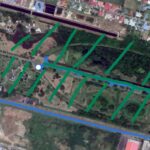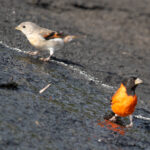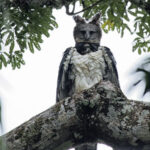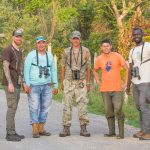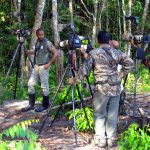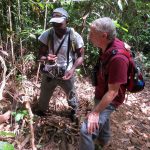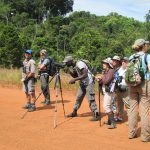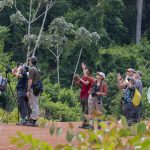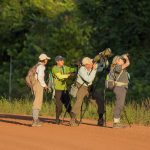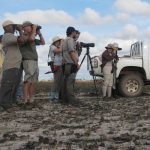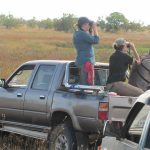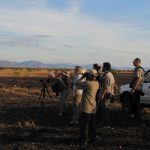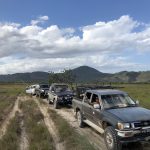Guyana is a small English-speaking country located on the Atlantic Coast of South America, east of Venezuela and west of Suriname. Deserving of its reputation as one of the top birding and wildlife destinations in South America, Guyana’s pristine habitats stretch from the protected Shell Beach and mangrove forest along the northern coast, across the vast untouched rainforest of the interior, to the wide open savannah of the Rupununi in the south
Guyana hosts more than 850 different species of birds covering over 70 families. Perhaps the biggest attraction is the 45+ Guianan Shield endemic species that are more easily seen here than any other country in South America. These sought-after near-endemic species include everything from the ridiculous to the sublime – from the outrageous Capuchinbird with a bizarre voice unlike any other avian species to the unbelievably stunning Guianan Cock-of-the-Rock.
Guyana is a small English-speaking country located on the Atlantic Coast of South America, east of Venezuela and west of Suriname. Deserving of its reputation as one of the top birding and wildlife destinations in South America, Guyana’s pristine. Birding group enjoying a great view of a Tree-toed Sloth near Atta Lodge habitats stretch from the rotected shell beach and mangrove forest along the northern coast, across the vast untouched rainforest of the interior, to the wide open savannah of the Rupununi in the south. Guyana hosts more than 850 different species of birds covering over 70 families. Perhaps the biggest attraction is the 45+ Guianan Shield endemic species that are more easily seen here than any other country in South America.
These sought-after near-endemic species include everything from the ridiculous to the sublime – from the outrageous Capuchinbird with a bizarre voice unlike any other avian pecies to the unbelievably stunning Guianan Cock-of-the-Rock. While the majestic Harpy Eagle is on everyone’s “must-see” list, other species are not to be overlooked, such as Rufous-throated, White-plumed and Wing-barred Antbirds, Gray-winged Trumpeter, Rufous-winged Ground Cuckoo, Blood-colored Woodpecker, Rufous Crab-Hawk, Guianan Red-Cotinga, white-winged Potoo, Black Curassow, Sun Parakeet, Red Siskin, Rio-Branco Antbird, and the Dusky Purpletuft. These are just a few of the many spectacular birding highlights that can be seen in this amazing country.
Not only is Guyana a remarkable birding destination, but it also offers tourists the opportunity to observe many other unique fauna. The elusive Jaguar can sometimes be seen long trails and roadways. Several species of monkeys including Red Howler, Black Spider, Wedge-capped Capuchin, Brown Capuchin, Golden-handed Tamarin, Brown-bearded Saki and Squirrel Monkey are frequently seen in their natural habitats. As if that isn’t enough, you are nearly certain to see Capybara, Black Caiman (the largest member of the alligator family), Sloths, and Giant Otters. Other animals that are either less common or more elusive and therefore less likely but still possible to find are Tapir, Anaconda, Puma, and Giant Anteater. The largest fresh-water scaled fish in the world, the Arapaima, can be observed, along with an amazing diversity of reptiles and amphibians that will enhance your birding adventure.
Although this tour is usually operated as a scheduled departure with a fixed date,
please contact us for a customized itinerary to suit your interests and schedule.
| DAY 1 | 09-Oct-2024 | Arrive in Georgetown |
| DAY 2 | 10-Oct-2024 | Georgetown and Sounding |
| DAY 3 | 11-Oct-2024 | Georgetown to Atta Lodge |
| DAY 4 | 12-Oct-2024 | Atta Lodge and Surrounding |
| DAY 5 | 13-Oct-2024 | Atta Lodge and Surrounding |
| DAY 6 | 14-Oct-2024 | Atta Lodge to Surama Lodge |
| DAY 7 | 15-Oct-2024 | Surama Lodge and Surrounding |
| DAY 8 | 16-Oct-2024 | Surama Lodge to Caiman House Lodge |
| DAY 9 | 17-Oct-2024 | Caiman House Lodge and surrounding |
| DAY 10 | 18-Oct-2024 | Caiman House to Manari Ranch via Karasabai for the Sun Parakeet |
| DAY 11 | 19-Oct-2024 | Manari Ranch and Surrounding and transfer to Whichabai Ranch |
| DAY 12 | 20-Oct-2024 | Whichabai Ranch and Surrounding |
| DAY 13 | 21-Oct-2024 | Whichabai Ranch to Georgetown |
| DAY 14 | 22-Oct-2024 | International flight back home |
DAY 1
Our tour will begin from the Cheddi Jagan International Airport. You tour leader Leon Moore or driver will be waiting to collect you from the Airport and transfer you to your hotel. The driver from the airport can take approximately 1 hours during the late hours of the night or up to 2 hours depending on the flow of traffic during the day time.
Georgetown is located in the north of Guyana on the Atlantic coast, and about a one-third of the Country’s population lives in this English speaking metropolis. The Georgetown Botanical Garden is a wonderful spot, despite
heir location in central Georgetown there are exclusive grounds of large tropical trees, lawns and wetland provided for some exciting birding. Some of the species we are likely to see includes Great Black-Hawk, Common
Black-Hawk, Zone-tailed Hawk, Snail Kite, Green-rumped Parrotlet, Great Horned Owl, Orange-winged and, Yellow-crowned Amazons in very good numbers and Festive Parrot. White-bellied Piculet, Wing-barred Seedeater, Wattle Jacana, White-throated Toucan, Pied Water-Tyrant, Red-Shoulder Macaw, Yellow-chinned Spinetail, Grayish Salator and a number of other amazing birds. Birding in the garden gives a great introduction to the birds of Guyana.
Overnight at the Grand Coastal Hotel
DAY 2
Mahaica River tour, Bounty Farm or Botanical Garden Tour This Morning we will leave our hotel at 5:00am and head eastward along the Atlantic coast to the Mahaica River, this is where you will have an opportunity to see and photograph Guyana’s national bird, the “Hoatzin”. This pre-historic bird is abundantly found along this amazing river system. We very often see the beautiful Blood-coloured Woodpecker among many other target birds as well. The rare and elusive Blood-coloured Woodpecker is a species most birdwatchers visiting Guyana wish to add to their birding list and we have a very good chance of seeing it or perhaps, taking some pictures. The Blood-colored Woodpecker is among one of the restricted species to the narrow coastal plains and is considered a Guianan shield endemic species.
On the way to Mahaica or on the return trip, we will be stopping at some of the mud-flats and mangrove forest for a chance to observe several birds. These includes the very colorful Scarlet Ibis, Little blue, Tricolored and Cocoi Heron. Larg-billed and Gull-billed Tern, Semipalmated Sandpiper, Semipalmated Plover, Whimbrel, Mangrove Rail if you’re lucky, Northern Scrub Flycatcher, Lesser Nighthawk at day roost, Pied Water Tyrant, Bicolored Conebill, Black-throated Mango, Spotted Tody-Flycatcher, Rufous Crab-Hawk and many other species.
Once we arrive at the Mahaica river, we will begin the tour. Other birds we often see along the river includes, Black-collared Hawk, Black Hawk Eagle, Barred Antshrike, Black-crested Antshrike, Silvered Antbird, Striped Cuckoo, Little Cuckoo, Green-tailed Jacamar, Long-winged Harrier, Brown-throated Parakeet, Red-shoulder Macaw, Orange-winged and Yellow-crowned Parrot, Winged-barred Seedeater, Pale-breasted Spinetail, White-tailed Goldenthroat, Green-tailed Goldenthroat, White-bellied Piculet and many other species. We will keep our eyes out for the Guianan Red Howler Monkeys as this is the best place to see and photograph them. If we see them, you will notice they are quite happy to sit around in the trees without even feeling scared of you; a clear sign that they are not hunted nor do they have any predators around this area. With good weather, this should be a trip that is well worth doing.
After Lunch, if there is enough time to get to Bounty Farm, we will head south to this amazing birding hotspot. The farm is located about 1.5 hour away from the Hotel. Note; during the afternoon, the area we have to drive most times have heavy traffic and this can cause delays in getting to the farm with enough time for birding. Some of the species we often see here includes, Rufous-breasted Hermit, Slender-billed Kite, Black-throated Mango, Green-throated Mango, Blood-coloured Woodpecker, Cream-colored Woodpecker, and the outrageous Crimson-Hooded Manakin. Bounty Farm is the only place on the tour where you will have a chance to see this Manakin. If the fig trees are fruiting during the time of the tour, we stand a very good chance of seeing the beauty. If not, then it is very difficult and almost impossible to see because they are attracted by the fig trees. If we do not have enough time to visit this farm, then we can return to the Botanical Gardens. Some of the likely species in the gardens includes, the Green-rumped Parrotlet, Great Horned Owl, Orange-winged and, Yellow-crowned Amazons in very good numbers and this is the only place to see our target; the Festive Parrot. White-bellied Piculet, Wing-barred Seedeater, Wattle Jacana, White-throated Toucan, Pied Water-Tyrant, Red-Shoulder Macaw, Yellow-chinned Spinetail, Grayish Salator and a number of other amazing birds.
Overnight at the Grand Coastal Hotel (B)
DAY 3
Georgetown to Atta Lodge After an early breakfast at your hotel, you will be transferred to ogle airport where you will connect with your scheduled flight to Lethem. From here, you will be transfer by 4×4 to Atta Lodge. Lethem is the capital of Region 9 and is a hub linking many of the surrounding villages to Georgetown. The Takutu River Bridge over the Takutu River was recently completed and now links the two countries. The newly built bridge is expected to bring Brazilian goods to the Georgetown harbor which would be faster than
shipping through Brazilian ports.
flight to Lethem is approximately one hour and the transfer to Atta Lodge via dirt road is approximately three hours including a few stops for birding and possibly and possibly wildlife sighting especially the very strange but beautiful Giant Anteater which we would have seen on previous trips. Since this will be your first time in this part of the region, we may see birds like the Jabiru and Maguari Stork, Savanna Hawk, Red-shouldered Macaw, Plumbeous Seedeater, Aplomado Falcon, White-tailed Hawk, King Vulture, Orange-backed Troupial, Crested Bobwhite, Common and Plain-breasted Ground-Dove, Pinnated and many other birds. Upon arrival you will be welcome by the staff before having Lunch then settle into your room. The Atta Rainforest Lodge is situated approximately 750 meters from the Iwokrama Canopy Walkway.
The walkway has three platforms, the highest of which is over 30 meters above the ground, and these will allow us to get great looks at a range of canopy species. Among the likely highlights are Painted, and Golden-winged Parakeets, Caica Parrot, Guianan Puffbird, Waved and Golden-collared Woodpeckers and Spot-tailed, Todd’s and Ash-winged Antwrens. The walkway is also an excellent place to look for various species of Cotingas including the Dusky Purpletuft, Purple-throated Fruitcrow, Pompadour and Spangled Cotinga and if there are any suitable fruiting trees nearby, we stand a good chance of seeing these birds as well as Purple-breasted Cotinga.
Another area where we will want to spend some time is the clearing around the lodge, as this is one of the best places to see the Crimson Fruitcrow. This species is seen here on a reasonably regular basis, as it often comes to feed in some of the nearby trees. The clearing is also a site for Black Curassow as there is a family party that comes out to feed on the forest edge. With reasonable luck, we should be able to add this bird to the impressive list of species we hope to see around the lodge and walkway.
Overnight at Atta Lodge (B,L,D)
DAY 4
Atta Rainforest Lodge and Environs This morning we will head out to the walkway at first light for opportunities to spot canopy species including Todd’s Antwren, Spot-tailed Antwren, Pygmy-Tyrant, Guianan Toucanet, Green Aracari, Painted Parakeet, Screaming Piha, Black-headed Parrot, Guianan Puffbird, Dusky Purpletuft, Great Jacamar, Paradise Tanager, Blue-backed Tanager, Golden-sided Euphonia, Purple and Green Honeycreepers, Black-faced Dacnis, Long-billed Gnatwren, Buff-cheeked Greenlet, Tiny Tyrant-Manakin and Black Nunbird. This entire morning will involve birding on the canopy walkway and the trails around the lodge.
Within the forest that surrounds the lodge we can look for Black-faced Hawk, Spotted Antpitta, Red-and-Black Grosbeak, Grey- (Black Curassow) winged Trumpeter, Cayenne Jay, Amazonian Barred Woodcreeper, Red-billed Woodcreeper, Helmeted Pygmy-Tyrant, Painted Tody- Flycatcher, Ferruginous-backed Antbird, Guianan Warbling Antbird, White-crested Spadebill, and Waved, Chestnut and Red-necked Woodpeckers.
After lunch, we will spend the afternoon birding on the main road through the Iwokrama Forest and also visit another nearby white sand forest to target the Pelzeln’s tody-Tyrant, Yellow-throated Flycatcher, Guianan Red Cotinga, Bronzy Jacamar, Red-legged Tinamou, Guianan Schiffronis and many other amazing birds within this forest. Meanwhile, along the main road, we will be looking for Blue-backed Tanager, Guianan Streaked Antwren, Ash-winged Antwren, Spot-winged Antwren, Golden-sided Euphonia Amazonian and Mouse-colored Antshrike, Reddish Hermit, Tiny Tyrant-Manakin, Rose-breasted Chat, Black and Red-throated Caracaras, Guianan Trogon, Golden-winged Parakeet and Yellow-green Grosbeaks are all possibilities. While birding along the road, we will also keep our eyes open for the elusive Jaguar and Tapir which we sometimes see at dawn and dusk. On our way back to Atta Lodge, we will use flashlights or spotlights to do some night birding, mainly looking for Owls and Potoos.
This is a great place to look for White-winged Potoo, Great Potoo, Common Potoo and Long-tailed Potoo, plus Northern Tawny-bellied Screech-Owl, Spectacled Owl, Black-banded Owl,Amazonian Pygmy-Owl and Crested Owl.
Overnight at Atta Rainforest Lodge (B,L,D)
DAY 5
Atta Rainforest Lodge and Surrounding Today we will continue birding along several forest trails, the main road, and possibly the Walkway. At dawn we will rise early and begin our day spending some time around the clearing before taking the trails at the lodge. We will be mainly looking for our targets including Crimson Fruitcrow, Guianan Toucanet, Painted Tody-Flycatcher, Blue-backed Tanager, Golden-sided and Plumbeous Euphonia. We will then continue birding the trails looking for Red-and-Black Grosbeak, Royal Flycatcher, Spotted Antpitta, Gray-winged Trumpeter, Tiny Tyrant-Manakin, White-throated Manakin, Red-billed, Chestnut-Rumped and Amazonian-barred Woodpecker.
Among forest flocks includes Rufous and Brown-bellied Antwren, Dusky-throated and Cinereous Antshrike, Long-winged, Gray and white-flanked Antwren, Olivaceous Flatbill, Whiskered Flycatcher and Tawny-crowned Greenlet. The Walkway will be a good spot to look for some high canopy specialist includes Buff-cheeked Greenlet, Guianan Woodcreeper, Todd’s and Spot-tailed Antwren and Guianan Puffbird. While on the walkway we will keep our eyes out for Blue-Cheeked, and Red-fan Parrot, Guianan Trogon, Painted Parakeet and the high flying and most times hard to see, Lilac-tailed and Sapphire-rumped Parrotlet and once trees are blooming we should see Fiery-tailed Awbill, Rufous-throated Sapphire, Fork-tailed Woodnymph, and possibly Crimson Topaz.
After breakfast we will spend some more time around the clearing looking for Crimson Fruitcrow, Green Aracari, Blue-backed Tanager, Guianan and Olive-green Tyrannulet and most times in the forest at the lodge, Guianan-red Cotinga and Red-billed Woodpecker. We will then head back in the trails looking for Black-throated Antshrike, Ferruginous-backed Antbird, the very hard to find Rufous-winged Ground-Cuckoo and keep a very close eye out for Black-face Hawk. After Lunch the entire afternoon will be spent looking for birds that we might have missed during the morning and eventually venture out and along the main road at a spot where the Crimson Topaz now holds as a favorite area. Return for Dinner.
Overnight at Atta Rainforest Lodge (B,L,D)
DAY 6
Atta Rainforest Lodge to Surama Lodge via Cock-of-the-Rock Lek Today we will rise before dawn, have some coffee, and then take our final morning at Atta Lodge birding the clearing around the Lodge to try for a few of our target species that we might have missed or to just get better looks at ones we’ve seen, including Green Aracari, Guianan Toucanet, Guianan Trogon, Painted Tody-Flycatcher, Guianan Tyrannulet and more.
After our early morning birding and breakfast, we will venture onward to Surama Lodge with an important stop at a (Guianan Cock-of-the Rock) Guinean Cock-of-the-Rock lek, where this stunning bird is regularly seen as the males display for females. The lek’s location is about a 20- minute walk on a flat forest trail. We should have a good chance to see and photograph this unique bird. Some other species regularly seen along this trail include Yellow-billed Jacamar, Rufous-winged Ground Cuckoo, Spotted Antpitta, Amazonian Motmot, acarlet and Red-and-green Macaws, Painted Parakeet, White-plumed and Rufous-throated Antbird, and more. We then continue to the Amerindian village of Surama, where you will be welcomed by the staff and then settle in to your basic accommodation for the next two nights.
The Amerindian community of Surama is located in the heart of Guyana. The village is set in five square miles of savannah which is ringed by the forest-covered Pakarima Mountains. Surama’s inhabitants are mainly made up of the Makushi people, one of the nine indigenous people of Guyana, and they still observe many of the traditional practices of their ancestors. After lunch, will venture out into the savanna and through the forest for a chance to find White-naped Xenopsaris and the Sooty-capped Hermit. We will continue back out along the main road to target bird like Crimson Fruitcrow, Olive-green Tyrannulet, Blue-cheeked Parrot, Caica Parrot, Dusky Parrot, Painted Parakeet, Variable Chachaca, Black Spotted-Barbet, Tiny Hawk and many other targets. Depending on how productive our afternoon is on the road, we will wait and return back to the Lodge after Sunset while using our spot lights looking for other night birds and mammals of we are lucky.
Overnight at Surama Lodge (B,L,D)
DAY 7
Surama Lodge and Surroundings Today we will be spending the entire morning birding the trails surrounding habitats at the Lodge. Our main focus would be to target several species of birds including, Ocellated Crake, Black-spotted Barbet, Red-legged Tinamou, Spotted Antpitta, Fiery-tailed Awlbill, Capuchinbird, the elusive Rufous-winged ground Cuckoo, Ash-winged Antwren and Chivi Vireo. Black Nunbird, Wing-banded Antbird Rufous-throated Antbird and Black-chinned Antbird.
In addition, we will be targeting Todd’s,Spot-tailed and Ash-winged Antwren which is found more in the canopy forest flocks along with Guianan Woodcreeper, Golden-colored Woodpecker and Red-billed Woodpecker. Return to Surama Lodge for Lunch.
During our stay at Surama Lodge, we also have a chance to target the very difficult Ocellated Crake. We will also try for Spotted Antpitta, Gray-winged Trumpeter, Tiny Tyrant-Manakin, Waved Woodpecker, Red-billed, Chestnut-Rumped and the Guianan Woodcreeper. We will remain alert in hopes of spotting the very elusive Rufous-winged Ground Cuckoo, and since our guides have found an area where this rare bird has been seen on several trips, we will be on the lookout for this amazing bird.
Depending on what targets we may still need, we will decide on the ground whether to bird along the road or the trails surrounding Surama Lodge. We will have the option to join our 4×4 and head out along the main Georgetown/ Lethem road. This is another excellent area to target birds including Crimson Fruitcrow, Blue-cheeked Parrot, Black-spotted Barbet, Marail Guan, Guianan Red Cotinga, Guianan Puffbird, Guianan Toucanet, Green Aracari, Guianan Trogon, Caica Parrot, Dusky Parrot, Waved Woodpecker, Black Nunbird, Blue-chinned Sapphire and Dusky Purpletuft. After our time along the road, we will return to the Lodge for dinner.
Overnight at Surama Lodge (B,L,D)
DAY 8
Transfer to Caiman House After another early breakfast, we will transfer to Caiman House with stops along the way to check a few forest edges and many savannah ponds. If we are lucky, we should come across some more common species such as Grey-cowled Wood-Rail, Cocoi Heron, Maguari Stork, Buff-necked Ibis, and the stunning Jabiru Stork. Raptors in the area include Savanna, White-tailed Great Black and Zone-tailed Hawk. The morning journey will end at Caiman House where we will be welcomed by the staff, settle in to our accommodation, and then have lunch.
Caiman House Field Station was built in Yupukari by an American family who moved to the area so Peter Taylor could conduct a field study on Black Caiman (Melanosuchus niger), the largest member of the alligator family and a species that is listed by CITES as endangered. Black Caiman are severely depleted in nearly all of their former range, but are found in abundance in the waters of the Rupununi River. The field study is an attempt to gain an understanding of the Black Caiman’s ecological role, as well as its context within local communities. By basing the study in a local village, and using local residents as assistants, it will hopefully instill a better understanding of the caiman’s importance in the local ecosystem. It is also hoped that a healthy population could lead to a sustainable resource, possibly through ecotourism. Guests are invited to join the caiman research crew in a night of caiman capturing. It’s a bit like having a job with a National Geographic crew.
Our afternoon will be spent patrolling the gallery forest surrounding Caiman House in search for more target species including Spotted Puffbird, Green-tailed Jacamar, Blue-backed Manakin, Golden-spangled Piculet, Northern Slaty-Antshrike, Slate-headed-Tody Flycatcher, Bare-necked Fruitcrow, Yellow-Olive Flycatcher, Pale-tipped Tyrannulet, Guianan-warbling Antbird, Southern white fringed Antwren, Sooty-capped Hermit, Red-capped Cardinal, Yellow-crowned Parrot, Brown-throated Parakeet and many other amazing birds.
Overnight at Caiman House (B,L,D)
DAY 9
Caiman House and Environs After an early breakfast, we will have a chance to do some birding in the Savanna and forest patches that surrounds Caiman House. We will be mainly looking for several of our target birds including the Crested Doradito, Bearded Tachuri, Jabiru Stork, Maguari Stork, White-face and Black-bellied whistling Duck, Pinnated Bittern, White-tailed Hawk, Savanna Hawk, Zone-tailed Hawk, White-tailed Kite, Aplomado Falcon and many other species. We may also see Sharp-tailed Ibis, Yellowish Pipit, White-tailed Goldenthroat Double striped Thick-knee, King Vulture and Orange-backed Troupial. In addition, this will be the best time to see the very beautiful, Giant Anteater! If we’re lucky enough to find one, we will enjoy the view and possibly take pictures. Eventually we will make our way back to Caiman House before lunch.
In the afternoon we will take a boat trip on the Rupununi river. Here we are likely to find kingfishers including both Green-and-Rufous and American Pygmy, if we are lucky, we may see the beautiful Agami Heron, Capped Heron, Sungrebe, Sunbittern, Pied Lapwings, Boat-billed Herons, Large-billed Tern, Black Skimmer, Pale-legged Hornero, Bare-necked Fruitcrow, and we may have a chance to spot the very shy Crestless Curassow. In addition, we may see both Black and Spectacled Caimans, Giant River Otter, many species of monkeys, and largest fresh-water scale-fish in the world; the Arapaima. As the sun sets we may see Band-tailed Nightjars and possibly Nacunda Nighthawk and Common Potoo on the way back with the boat.
Overnight at Caiman House (B,L,D)
DAY 10
Caiman House to Karasabai This morning we will continue on our journey to Karasabai on rough road passing through very nice habitats such as open savanna and the Pakarima mountain range with gallery forest patches. Here Aplomado Falcon hunts over expansive plains with Grassland Yellow-Finches mixed with a variety of seedeaters, including Gray, Plumbeous, Chestnut, Ruddy and Lined Seedeaters. We also have good chances of encountering Giant Anteaters as they pass through the savanna. We will be passing lots of ponds, so these spots should produce very good birding opportunities for water birds such as herons, egrets and storks. We’ll need to keep an eye overhead as well for the raptors likely for this area: Savanna and White-tailed Hawks along with Lesser Yellow-headed and King vultures. Many other great birds should be seen on the drive to this very remote village of Karasabai with its exceptionally friendly residents.
Upon arrival we will take time to visit some of the locals in order to secure official permission to bird the area. There are very few visitors here and we wish to ensure good relations and encourage ongoing conservation efforts, especially when considering that these people ultimately control the fate of the Sun Parakeet. This riparian forest along the border of Brazil where we will be birding during the morning offers some very interesting birding opportunities. Our primary target species will be the Sun Parakeet, but we will also have chances to observe many other birds, including Red-and-Green Macaw, Green-rumped Parrotlet, Black-and-White Hawk-Eagle, Zone-tailed Hawk, Rufous-browed Peppershrike, Toco Toucan and Ferruginous Pygmy-Owl, to name but a few.
Following lunch in the village, we will bird our way back to Manari Ranch, which is located just 15 minutes outside the town of Lethem near the Brazilian border. Upon arrival, we will meet our local guide who will be taking us to look for the very rare Rio Branco Antbird and the Hoary- throated Spinetail next day. We will settle into our very simple but comfortable accommodation for the next two nights.
Overnight at Manari Ranch (B,L,D)
DAY 11
Manari Ranch and transfer to Wichabai Today well focus our attention on two birds with exceedingly restricted ranges, the Hoary-throated Spinetail and the Rio Branco Antbird. Both species are only found in gallery forest along the Rio Branco River and other main tributaries, all of which ultimately flow into the Amazon. Recent agricultural pressures have seriously reduced the amount of available habitat for these birds, and as a result the Spinetail is now classified as endangered, with the Antbird treated as near-threaten. In addition, there is good news surrounding the faith of both species. The South Rupununi Conservation Society received funding from National Geographic in 2021, which would be use to carry out several bird surveys and research within the gallery forest along the Iring river and other surrounding habitats where the Rio-Branco Antbird and Hoary-throated Spinetail is found. The ultimate goal is for this area to become a new KBA or IBA area. for these birds, we will travel via 4×4 through the open Savannah. In order to reach suitable habitat Along the way we might come across Maguari and Jabiru Storks, Black-Collared Hawk, Ring Kingfishers, and Rufous-tailed Jacamar. Black-chinned Antbird, Orange-backed Troupial and other species before reaching our site along a comparatively short stretch near the Iring River.
We will specifically target the Hoary-throated Spinetail and the Rio Branco Antbird in this area, although other interesting species may include Pale-legged Hornero, Double-striped Thick-knee, Golden-spangle Piculet, and Ferruginous Pygmy-Owl, Flavescent Warbler, Bearded Tachuri, Aplomado Falcon, Nacunda Nighthawk and more. The entire morning will be spent birding in this area. After our time here, we will return to the Ranch for Lunch.
After Lunch, we will get ready for our journey to Whichabai Ranch in search of the highly endangered Red Siskin in South Rupununi. Our Rupununi team will be waiting with their 4x4s to take us on the journey to Whichabai. From Lethem, Whichabai is approximately 90km away, so we will not waste any time as the drive could take close to 3.5 hours, all of which will depend on the road condition. Nevertheless, Whichabai is located in the south Rupununi savanna region and along the way; we will see why this is one of the most beautiful region in Guyana. With spectacular grasslands, mountains, and forest. We will be passing through some of the indigenous Amerindian villages, plus some of the local cattle ranches before reaching our destination.
Along the way, we expect to do some birding looking out for birds like the Jabiru Stork, Double- Stripped Thick-knee, Crested Bobwhite, Yellowish Pipit, Plain-breasted Ground Dove, Ferruginous-Pygmy Owl, Brazilian Teal, Blue-winged Teal White-tailed Kite, White-throated Kingbird, South American Snipe, Giant Snipe, White-naped Xenopsaris, the very shy Sharp-tailed Ibis, Northern Scrub Flycatcher, Black-bellied Whistling Ducks, Bearded Tachuri, Yellowish Pipit, Grassland Sparrow, Aplomado Falcon and much more. We hope to arrive at Wichabai ranch in time for dinner and get ready for an early start next day.
Overnight at Whichabai Ranch (B, L, D)
DAY 12
Whichabai Ranch and Surroundings Today we have an extremely early start in search of the highly endangered Red Siskin. A fairly large population of Red Siskin was discovered in this region in 2003, far removed from any previously known colony, and we stand a good chance of observing this strikingly plumage species with an estimate world population of 600-6000 pairs. Our main objective will be to focus on locating the Siskin as this activity is just for one day at this stage of the tour and also due to the very long distance we have to cover in getting to and from the area, the sooner we can find them the better. While our main focus will be on the Red Siskin they are other birds that we might come across including, Pale bellied Tyrant-Manakin, White-barred Piculet, Bicolored Hawk, Savanna Hawk, and White-tailed Hawk, Zone-tailed Hawk, Flavescent Warbler, Ferruginous-Pygmy-Owl, White-bellied Antbird, White-fringed Antwren, Crested Bobwhite, and many more. We will return to Whichabai Ranch for Lunch. The entire afternoon will be spent either trying to locate the Siskin in case we might have missed out on seeing it during the morning. Or, perhaps birding the surrounding habitats at Whichabai looking for the rare Sharp-tailed Ibis, or even the Pale-belied tyrant- Manakin that we often see along the nearby Rupununi River. We will keep our eyes out for the while-barred Piculet, Finsch’s Euphonia and the Rufous-winged Antwren as well.
Overnight at Whichabai Ranch (B,L,D)
DAY 13
Whichabai to Georgetown Today will be our final day in the Rupununi. After breakfast, our 4x4s will take back to Lethem where we will connect with our schedule flight back to Georgetown. The flight to Georgetown is 1 hour. Once we arrive in Georgetown, you will be transfer to your hotel. We will spend our final night in Guyana and celebrate your journey and experience of this beautiful country.
Overnight in Georgetown (B, L)
DAY 14
Bon Voyage! Today you will catch your international flight home. See you again soon!
COST DETAILS
Rates are subject to change due to currency fluctuation Tour prices are based on quoted costs from the lodges (in our local currency), estimated fuel costs, and the rate of exchange the time of itinerary publication. The erratic nature to global financial markets makes it difficult to predict changes in costs and foreign currency exchange rates over the long term. Since tours are priced well in advance of the actual operation of the tour, tour costs, fuel costs and exchange rates can change, sometimes drastically. Depending on the extent of such changes, it may be necessary to implement a surcharge on this tour. If a surcharge is necessary, every effort will be made to minimize the amount.
- Price shown is in US Dollars, subject to change without notice
- Quoted prices are per person based on sharing in double accommodation
- Single supplement accommodation subject to availability
| 4 Guests | 5 Guests | 6 Guests | 8 Guests |
|---|---|---|---|
| US $ 6,450 p/p | (email us) | (email us) | (email us) |
We’ve decided not to include any cost for breakfast on your departure day, day 14th, 22nd Oct as British Airways and several other airlines mainly arrives around mid-night in Guyana and meals are not available this late at your hotel.
At the End of the Tour on day 14, if anyone from the group have a different departure timing or decide to stay back in Guyana for another day or so, then you’re responsible for covering your own meals and accommodation. The cost for meals varies from US$ 5,7 to US$50 per meal. Most likely you will choose whatever you want from the menu there. Only our hotel in Georgetown will accept credit card.
INCLUDED
- All other meals are included; from breakfast on Day 2 to Dinner on day 13
- All bottled drinking water during the tour
- All lodging during the tour
- All Activities as mentioned in the itinerary
- All ground transfer in between lodges, pick up and drop off at international Airport, all transfers for birding in Georgetown, scheduled internal flights.
- All national park and other services entrance fees., Iwokrama forest entrance fee, Surama village fee, and Karasabai Village fee, Conservation fees for Red Siskin and conservation fee for Rio-branco Antbird and Hoary-throated Spinetail tour.
- All guiding services
- All lodging at the lodges and hotel in Georgetown
EXCLUDED
- Day 1 dinner, 9th Oct arrival day
- Alcoholic Drinks
- Excess weight on the internal schedule flight to Lethem
- Extra Activities * Extra transfers *Special gratuities, all phone calls and any other personal item of any nature
Rates are subject to change due to currency fluctuation
Tour prices are based on quoted costs from the lodges (in our local currency), estimated fuel costs, and the rate of exchange the time of itinerary publication. The erratic nature to global financial markets makes it difficult to predict changes in costs and foreign currency exchange rates over the long term. Since tours are priced well in advance of the actual operation of the tour, tour costs, fuel costs and exchange rates can change, sometimes drastically. Depending on the extent of such changes, it may be necessary to implement a surcharge on this tour. If a surcharge is necessary, every effort will be made to minimize the amount.
TERMS AND CONDITIONS
- All requests for provisional or confirmed reservations are to be made by the Guest/Tour Operator by way of e-mail.
- No reservation will be deemed confirmed unless acknowledged and accepted in writing by Leon Moore Nature Experience. Leon Moore Nature Experience will respond to all reservation applications in a timely manner and will reply using the same medium of communication whereby the request was made.
Please review our full TERMS AND CONDITIONS on this website. Participating our tours indicates your acceptance of those Terms and Conditions.
PAYMENT PROCEDURE
You are required to make a non-refundable 20% deposit of the cost for the tour based on the number of clients and reservation made upon confirmation of the tour. And the balance no later than 90 days of the tour date. All payments should be addressed to Leon Moore via wire transfer. Please advise journeyguyana@gmail.com when the deposit is made in writing.
CANCELLATIONS
Should any reservation or payment provision not be observed by the reserving party, Leon Moore Nature Experience will be entitled to cancel the respective reservation with immediate effect. This will be done by way of written notice.
CANCELLATION CONDITIONS
Should a cancellation be received before 95 days prior to arrival, no cancellation fee will be charged. Should a cancellation be received 85 days prior to arrival a 50% cancellation fee will be charged. Should a cancellation be received 70 or less days prior to arrival, no refund will be given.
Cancellation fees are calculated on the rate per person and on the total value of the trip. No refunds will be made for unused meals, accommodations, or other trip features. All reservation amendments or cancellations are valid only if advised and accepted in writing.
Leon Moore Nature Experience strongly recommend that guests consider a travel insurance policy, which may assist in offsetting any unforeseen cancellation charges. You may have the opportunity to transfer your booking to another tour or another person, provided you are unavoidably prevented from coming on the tour. In this case, you will bear any extra costs that such changes may incur.
Leon Moore Nature Experience will not be responsible for paying any bank fees or responsible for any exchange rates that may offset or affect any refund. Whatever the refund amount is, all clients will be responsible for paying those changes during the refund process. These fees will be calculated based on the amount and be deducted from your refund.

INTERNATIONAL FLIGHTS
The cost of this tour does not include the price of your international flight to and from Guyana. You are responsible for arranging these flights to and from Georgetown. I recommend that you arrive a day early to rest and adjust to the time zone.
DOMESTIC FLIGHTS
On domestic Schedule flights within Guyana, passengers are allowed a total of 20Lbs or 9kg of luggage on Aircraft; if one is over the limit, he or she is charged US$1 or GY$ 200 Guyana dollars for every pound over weight. It is important that clients must provide his or her body and luggage weight in advance so this can be provided to the domestic airline in Guyana.
TRIP INSURANCE IS STRONGLY RECOMMENDED
The purchase of trip cancellation insurance is strongly recommended. Leon Moore Nature Experience (LMNE) cannot accept liability for airline cancellations or delays or penalties incurred by the purchase of nonrefundable airline tickets or other expenses incurred by tour participants in preparing for this tour.
- Clothing Because most of our clients comes from either north America or the UK; we know that clients would sometimes have to travel with weather clothing/extra jacket for cold weather; these and any other clothing or items he or she wish to leave within our storage, arrangements can be made to facilitate this.
- Tips The cost does not include any tips however, it is totally up to you, if you feel that an individual/staff performed excellent and you wish to leave a tip please do. If you feel that your tour leader provided you with excellent service, you are free to tip him as well.
- Weather Guyana is generally hot and humid. We can expect all types of weather from warm and hot to cool and rainy at times. Please be prepared for this.
- Early Starts On most morning we will be up and out very early to take advantage of the cooler temperature and wildlife activity.
- Fitness This tour does not require a high level of fitness but participants should be in good general health as some of the birding will be done on foot and may require walking for several hours at times but at (slow pace). Should you have any physical limitation please let us know in advance before you leave your destination.
- Accommodation Accommodation is generally simple but comfortable, throughout they are no air conditioners at the interior lodges, you should not expect luxury accommodation, the lodges we use range from basic to very good, Caiman House Field Station, Surama Lodge, Atta Lodge, and Iwokrama River Lodge to name a few!
- Hot water Apart from your hotel in Georgetown, none of the interior Lodges have hot shower.
- Roads Some interior local roads can be bumpy at times based on condition.
- Vehicles The vehicle we used are generally 4×4 and sometime open tops so at times we can be either sitting or standing to get a better view of possible wildlife or the forest.
- Credit Cards None of the Interior Lodges accept Credit cards, on arrival and Can get money from a Bank, Cambio etc.
- Biting insects Mosquito nets are provided throughout the lodges, you can expect some biting insects like mosquitos, sandflies, (noseeams).
- Malaria The risk of catching Malaria is low.
- Electricity Electricity is available at all the lodges, Generator or Solar power. Although the lodges are 110V and the outlets/plugs are USA type.
- Immigration Please treat immigration checks as international standards e.g. no liquid, bug spray, cream etc. etc.
- Clothing & footwear Light material clothing that can dry quickly, long sleeve, shirt and trousers for trail walks and tour activities. No brightly colored clothing, you must bring clothing that blends with the forest. Ankle height hiking boots and sneakers, with socks.
- Trail Walks For extended period of tour activities, we recommend that you bring a 3 legged stool for you to sit on. Some tour excursions include standing for long hours. You will find having a 3 legged stool would come in handy. So please try your best to bring one with you.
